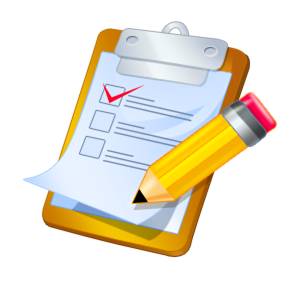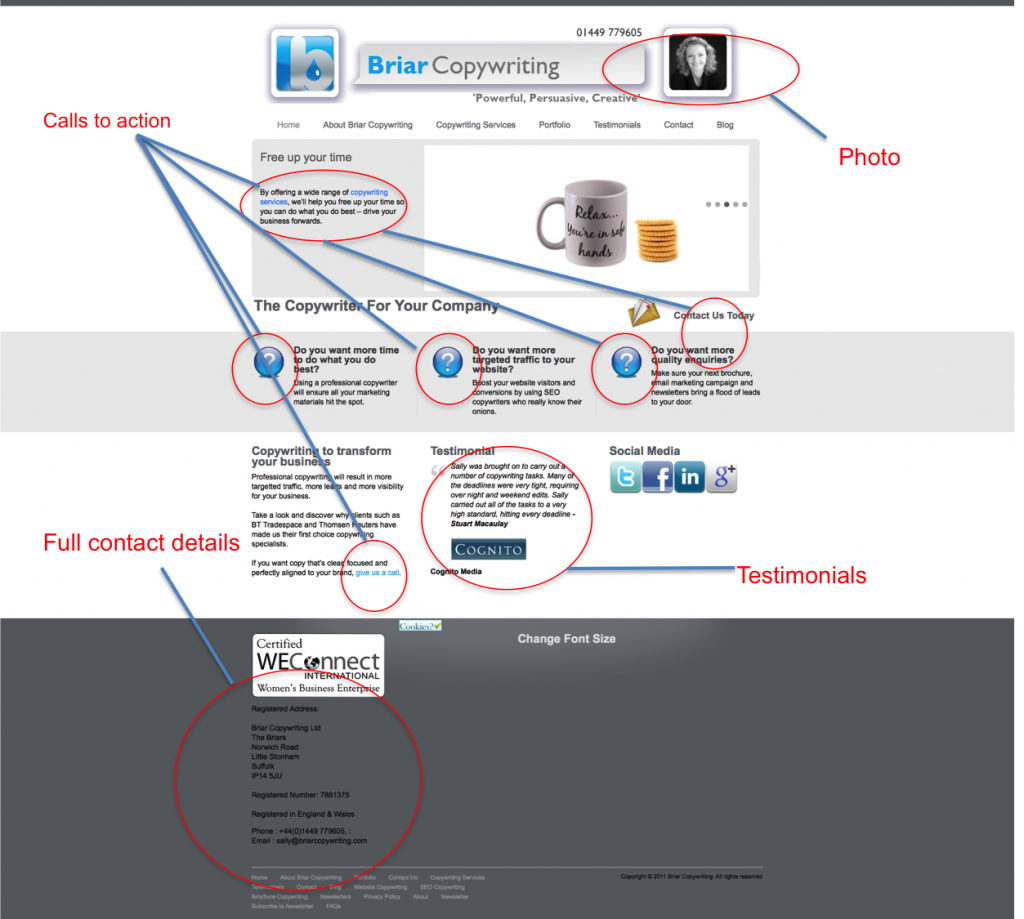Entries from August 2012 ↓
August 31st, 2012 — copywriter, copywriting, copywriting services, copywriting tips
As a copywriter my job is to help you communicate more effectively with your customers through writing. But on top of that, I’m also here to offer advice and make suggestions about how to improve your marketing strategy.
After spending many years perfecting my art and learning all about search engine optimisation of content and how to use different approaches to attract different audiences, you get a lot of experience and expertise for your money (as well as some stonkingly great copy).
So is there any occasion when hiring a copywriter isn’t a good idea?
Well, let’s look at it this way.
Below are 3 very good reasons why you should hire a copywriter (there are more than just these, but they give you the idea):
1. You want results, to project a professional image and instil trust in your readers
Every piece of marketing you place ‘out there’ represents your company. Therefore, the quality of your writing will have a direct influence on the perception people have of your business.
Using a copywriter will mean your content will be professional, speak to your readers and show them the benefits of working with you and offer a professional image.
2. You’re open to new ideas
The whole point about bringing in a professional copywriter on board is so that you can refresh and revitalise your marketing approach.
If you want to carry on in the same way, but simply can’t be bothered to write it yourself anymore, hiring a copywriter probably isn’t a great idea.
Part of their job is to look at your approach, understand why it’s not working and then devising a new a way of ‘speaking’ to your customers.
3. You’re not confident in your writing.
If you’re not a confident written communicator it will come across in your marketing materials.
Even though we write practically everyday, it doesn’t mean we are all experts in creating persuasive marketing copy.
The strongest business minds recognise their weaknesses and hire in the help of experts to strengthen those areas.
But, if you think you know better don’t call in a copywriter. That would be like going to the doctors about an ailment only to tell them they have no idea what they’re doing (despite the many years they’ve spent studying) and you’ll go back to the good old fashioned home remedy your mum always used to give you.
For the relationship to be fruitful and for you to see results you have to trust your copywriter, acknowledge that they are an expert in their field and take their advice on board.
Remember, the copywriter isn’t an expert in your business – that’s you – but they are experts at what they do. They know how to structure content and how to use language to persuade and connect emotionally with your readers.
August 29th, 2012 — copywriting tips, email marketing, Essential tools for small businesses, list building, online marketing
Email marketing is an incredibly effective marketing tool, but it can also be one of the fastest ways to ruin your business’s reputation. 
If you blatantly send out emails to thousands of random people who have either no prior knowledge in your company, or interest in what you do, you will be labelled a spammer – not good.
But, if you take the time to build your own email marketing list from people who have opted in to receive information and offers from your company, then you will be providing them with information they want to see – and that is good.
Of course, building your own list takes time, but if you are a WordPress user, there are a few tools you need to be aware of that could help you grow your email subscribers.
Recently, my attention was drawn to a useful post on the Socialmediaexaminer.com site that takes a look at 7 WordPress plugins that can be used to grow your email opt-in list.
They look at:
- Pippity customised popups
- Hellobar
- Comment Redirect
- WP-Leads
- OptinSkin
- Gravity Forms
- DiggDigg
You can see the full post here – 7 WordPress Plugins to Grow Your Email Subscribers.
So pop over there and have a look.
Growing your email subscribers is a great way to promote your business safely and get your content shared across the web, widening your reach out into your marketplace.
Over to you
Do you have any further tips on how to grow your email subscribers?
Perhaps there’s a different tool to those mentioned here that you use and have had success with.
Leave a comment below and share your experiences.
August 27th, 2012 — Content marketing, Content writer, copywriting tips, marketing, online marketing
With Google’s ever evolving algorithms, producing fresh content is more important than ever.
But does it have to be high quality or will any old thing do?
If you’re outsourcing your content production, don’t let financial matters cloud your judgement, as quality will always outweigh quantity.
Not convinced?
OK, look at it this way. Everything you put out on the web is there to promote your business in some way shape or form. It may not be a blatant advert, but it will be designed to drive traffic to your website and therefore will be associated with your company.
Now are you beginning to see why quality is important?
If you’re still struggling, here are 6 points worth remembering when it comes to content marketing.
1. Reflection
As mentioned above, every piece of content you put out under your company’s name will reflect on you.
If the content is sloppy, grammatically incorrect and downright boring, it will damage your reputation.
2. Crowds
Because there’s loads of content on the Internet, yours has got to stand out if it is going to be seen. Second-rate articles will fall by the wayside, but something that’s well written, engaging and informative will rise to the top of the pile.
3. Penguin
Google is the master at moving the goal posts, as demonstrated by its constant algorithm changes. The latest one, Penguin, can sniff out bad content a mile off. It looks at the time people spend on pages, how many shares they get and bounce rates etc., making it easy to sniff out the bad stuff.
So if you want your content to perform well in the search results, it’s got to be good.
4. Longevity
Unlike print, what appears on the Internet today isn’t going to be tomorrow’s chip wrappings. Once you publish an article under your name, it’s there for life. So if it’s badly written, it will have a long lasting detrimental effect.
5. Quality vs price
Rather than swallowing hard when the copywriter you approach tells you how much it will cost for a high quality, well researched and superbly written article, consider this. If the content is good and demonstrates a compelling reason for the reader to buy your product, its value is considerably more than one written as SEO padding that couldn’t even tempt someone lost in the desert to buy a bottle of water.
6. Business magnet
In the same way that people will judge your business on your website, brochures and emails, they will also judge you on your online content.
Badly written articles and blogs won’t inspire anyone to pick up the phone and want to do business with you.
These 6 reasons are why it is vital you put quality content before price. Even if that means you put less ‘out there’, what you do put out will bolster your reputation as a quality company that offers great information to its clients.
Can you really afford to jeopardise your reputation with sloppy, substandard content?
I doubt it.
August 24th, 2012 — copywriting, copywriting tips, Home Page, website copywriter, website copywriting
Your home page is probably the most important page on your website.
Creating content to make it effective takes time, skill and quite a lot of know-how.
So, where do you start?
Well, although your home page is probably the page visitors are most likely to arrive on, it isn’t a main sales page.
If you think about it, when you walk into a department store (or any store for that matter), all the goods are set out in relevant departments to make it easy for you to find what you want. Your home page should be the same; it is the place that directs the visitor to the section of your website they need.
Before you begin creating the content for your home page, you must decide what your objectives are. Do you want your visitors to:
- Buy something?
- Sign up for a newsletter/report?
- Fill out a contact form?
This will determine how you write and lay out your home page.
Let’s take a look at a few of the essential elements that should appear on your home page.
1. The content
This must talk directly to the reader (i.e. be written in the second person) and tell them what your website is about. It should be obvious from the start what you do and, more importantly, what you can do for your customers. In other words it must show your audience how you are going to make their life better.
2. Establish trust
If you want someone to do business with you, they have to be able to trust you.
How do you create that trust?
Simply by being transparent – show your full contact details (email, postal address and telephone), have a photo of you so they know whom they are dealing with and show testimonials from past clients.
If that sounds a lot for one page, take a look the home page for my copywriting company:

3. Calls to action
You can also see in the above illustration the calls to action.
These are vital to make sure your visitor is taken to the area of your site that is relevant to their needs. You can have more than one, but make sure they are clear and not overwhelming.
4. Clear navigation
Although your content will contain calls to action that will take your readers further into your site, it’s also important to have clear navigation at the top of your home page (and all your pages) so users can easily get to other pages within your site.
5. Links
Your links are like the transport infrastructure of your website so it’s essential to test them to make sure they work. Broken links won’t do anything for your reputation and may lose you potential clients.
There are other elements you could also add in such as search boxes and videos etc., but the elements listed above are really the bare essentials you need to create a good impression, help your visitors find what they want and ultimately, make it easy for them to buy from you.
Over to you
What other elements would you consider essential for a home page?
Leave your comments below.
August 22nd, 2012 — Customer service, email copywriting
Let’s face it dealing with phone calls takes time. Unless you have multiple phone lines, you can only answer one customer at a time leaving the others hanging on in frustration.
That’s also why so many customers like to deal in email rather than waiting in phone queues. That’s a bonus for you because you can sit back and deal with each email as it comes in.
But how you deal with them will say a lot about your company and your customer service.
So, how can you make a good impression?
1. Make sure you have an email address shown on your website
More and more companies just have contact forms on their websites. There’s nothing wrong with that so long as you make sure they are working and that they are monitored.
I’ve lost count of how many companies I’ve tried to contact this way only to never hear anything.
If you also list an email address, it offers reassurance to the reader that you’re a real company that wants to hear from its customers (the same goes for the inclusion of a telephone number and postal address).
2. Answer promptly
Even though they sent an email, your customer will still want a quick response. At the very least this should be the same working day, but preferably within the hour.
If you know it’s going to take a while to look into their query, at least send an email to reassure them that their email has been received and that you are looking into the matter and when you will get back to them. If you keep them updated in this way they at least know their query is important and is being looked into.
3. Name
Make sure you use their name in your response. There’s nothing worse than sending a company an email that included your name (in your signature and email address) only to receive a reply that started ‘Dear Sir/Madam’.
4. Thank you
It might sound obvious, but start off your response by thanking them for their email. Even if they were complaining about something it’s important to show them that their correspondence is important and valued.
5. Answer everything
Many emails will ask several questions, so make sure you answer everything. There is nothing more frustrating than receiving a reply to your query only then having to send another email because part of your initial question wasn’t answered.
Before you hit send, re-read your response to:
a) Make sure answered everything
b) Make sure there are no spelling or grammatical errors
6. Get straight to the point
The recipient of your response doesn’t want a great long essay turning up in their in box, so make sure you get straight to the point and answer their query.
Oh, and always end with something along the lines of ‘If we can be of further assistance, please get in touch’.
Although each of these points appears to be common sense, you’d be amazed at how many are ignored.
Over to you
Do you have any other tips you can add about using email as an effective customer service tool? If so, leave a comment below.
Sally Ormond – Copywriter










